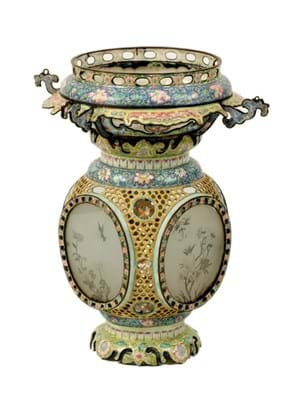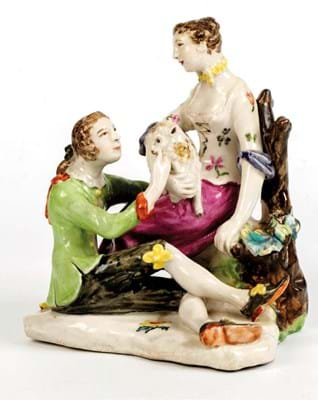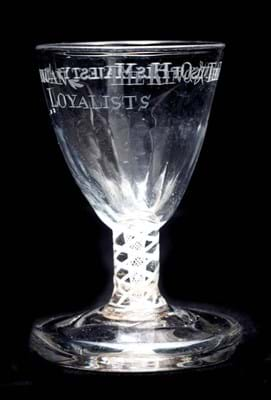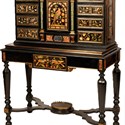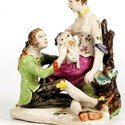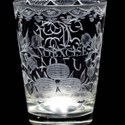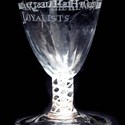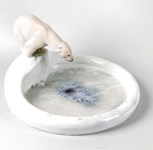It takes something special these days for a piece of furniture to be the soar-away star of a sale – particularly a sale with a couple of five-figure Chinese lots and attractive collections of glass and ceramic rarities.
The ‘something special’ at Duke’s (22% buyer’s premium) at Dorchester on February 23 was the 19th century Italian ebony, pietra dura and gilt metal cabinet illustrated on this page.
The 5ft 2in (1.58m) tall cabinet, with a shelved interior and parrots as the main decorative theme, had an apparent provenance to the sale of the Earl Fitzwilliam’s Wentworth estate in 1949 and was estimated at £10,000-15,000.
The general feeling was that the cabinet itself was c.1840 but that the pietra dura panels were earlier – hence the international interest which pushed the bidding to £66,000 at which it sold over the phone to an anonymous buyer.
Arts & Crafts furniture
Rather more likely to come most dealers’ way is Arts & Crafts furniture and its Cotswolds spin-offs currently in keen demand.
At Dorchester six pieces of oak furniture designed by Ambrose Heal for Heal & Son between the 1890s and 1920s filled the bill.
Bids ranged from £480 for a pair of bedroom chairs in the Fine Feathers pattern to £5600 for a Mansfield pattern gentleman’s wardrobe – a 6ft 3in tall x 4ft 1in wide (1.92 x 1.24m) piece with twin panel doors above a three-drawer base designed in 1889 and estimated at £1000-2000.
Best of the traditional antique material was a 4ft 8in (1.42m) tall Queen Anne walnut escritoire on stand featuring panels of floral marquetry to the upper section and similar, but ivory-embellished, marquetry to the fall which enclosed a fitted interior.
Catalogued as 17th century and later, the escritoire took £3400 from a UK private buyer against a £1500-2500 estimate.
Fantastic glass
A collection of 65 pieces of engraved English glass built up since the 1960s was particularly fine, said auctioneer Guy Schwinge.
“It was completely focused on commemorative rather than decorative pieces and containing some fantastic and unusual examples,” he said.
“The quality was second to none and we were fielding bids from the best glass dealers and collectors from across the country.”
Raising a hammer total of £61,000, 57 of the glasses sold, with the top two commemorating occasions of war and peace.
One was a c.1770, 4in (10cm) tall firing glass engraved to the flutemoulded bowl The King & the Friends of His Majesty’s American Loyalists.
Colonials fighting against the revolutionaries in the War of Independence get a very tough press as forces of the British crown so often do (compare, for instance, prices of Jacobite glass with contemporary Hanoverian commemoratives).
Had a rarity such as this firing glass – no comparable examples appear to be recorded – commemorated Washington’s army it would have been estimated at rather more than the £2000-4000 guideline, but considerable interest still emerged from US bidders.
One was notable Pennsylvanian collector Nick Manganiello, some of whose pieces are going into a new Revolution-themed museum in Philadelphia.
He secured the glass at £3800. Also selling at £3800, comfortably above the wide £1500-3000 estimate, was an 8½in (21.5cm) tall rummer inscribed Peace 1814.
Depicting Britannia, figures, a man o’war, an angel and a dove, the glass celebrated the end of the Napoleonic Wars (rather prematurely, as it turned out) with the Treaty of Paris.
The Loyalist glass and the rummer had sold respectively for premiuminclusive bids of £3700 at Bonhams in October 2003 and £2760 at Christie’s in March 2000.
Going way above estimate was a 5½in (13.5cm) tall tumbler engraved No Excise above three barrels and, to the reverse, a monogram and the date 1794.
In 1996 it took £850 at Christie’s and was given a £400-800 estimate at Dorchester but sold to a UK collector at £3200.
Saleroom history
A Qianlong c.1790 export porcelain part dessert service also came with a saleroom history, having been sold for a premium-inclusive £5175 at Christie’s in December 1996.
Decorated with courtly figures and landscape vignettes, the 96 pieces, including tureens, were estimated at a cautious-looking £1000-2000 but sold to a UK dealer at £10,000.
The Chinese market at auction is predictable to the extent that – as at Duke’s 135-lot offering – most pieces get away around their three-figure estimates and just one or two fly.
A 9½in (24cm) tall Cantonese enamel hanging lantern was catalogued as late Qing (early 20th century) and estimated at £150-300.
With reverse-painted panels, lotusdecorated vase-form chimney and silk trellis pendant collar, it caught a number of eyes before also selling at £10,000.
Mixed reception
Four pieces of St James’s porcelain, which had been in the Dorset vendor’s family since the late 18th century and were unearthed during a routine house valuation, had a mixed reception.
The St James’s factory, set up by Huguenot exile Charles Gouyn in around 1748 after he left the Chelsea factory, was the subject of detailed research by scholars before its output was given its name. The factory’s products remain rare and desirable.
However, bidding stopped short of requirements on two c.1755-60 scent bottles.
Each estimated at £3000-5000, the one 2¾in (7cm) high depicted a cockerel and chickens and the other, slightly smaller, was formed as a monkey with flowers and a baby on her back.
Prices for similar vessels have been strong in recent times.
A much more positive reaction greeted two c.1750-54 pastoral groups.
Each depicted a lady seated by a tree stump with a man looking on.
The first, 5¼in (13cm) high, was of a shepherdess cradling a lamb with a man crouched beside her. Against a very wide £5000-10,000 estimate, it sold at £12,000.
The other, 5in (12.5cm) high, in which an elegant lady held a dove with a gentleman by her side, was guided at £1000-2000 but went to a collector at £5000.
The same source yielded a very rare group of Worcester rococo condiment spoons, each enamelled in colours with flowers and heightened with puce and gilt, c.1755-60.
Pairs sold for £1200 and £1100 and a single example for £850.
Report By Terry Ryle


